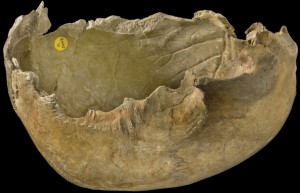 Three human braincases — one from a child about three years old, two from adults — found in Gough’s Cave, Somerset, England, have been radiocarbon dated to 14,700 years ago. These are the only skull-cups ever found in England, and although others have been found in Western Europe that date to around the same era (between 15,000 and 12,000 years ago) none of the continental ones have been direct dated by radiocarbon, only indirectly dated by analysis of something that was found next to them.
Three human braincases — one from a child about three years old, two from adults — found in Gough’s Cave, Somerset, England, have been radiocarbon dated to 14,700 years ago. These are the only skull-cups ever found in England, and although others have been found in Western Europe that date to around the same era (between 15,000 and 12,000 years ago) none of the continental ones have been direct dated by radiocarbon, only indirectly dated by analysis of something that was found next to them.
The Gough’s skull-cups also show evidence of advanced processing of the cadavers and shaping of the braincases. Frequent cut marks and percussion marks suggest that the skulls were stripped clean of all tissue, then the mandibles removed and cracked probably so the marrow could be eaten. The skulls were then carefully broken horizontally so the face was removed and only the cranial base remained, a convenient bowl shape made even more convenient by careful chipping along the broken edges to make for more comfortable sipping.
There are comparable examples of this process in the modern ethnographic record, as people were still making and using skull-cups in Fiji, for example, as late as the 19th century.
The Magdalenian is associated with widespread evidence for the artificial modifications of human remains. This contrasts with earlier Upper Palaeolithic periods such as the Gravettian, where primary inhumation (sometimes with elaborate grave goods) was the common burial practice. Earlier interpretations of Magdalenian cut-marked human bones have implicated ritual practices involving disarticulation, defleshing and excarnation, but the consumption of the human tissues has generally been dismissed. At only two other Magdalenian sites (Le Placard and Isturitz) has the production of skull-cups been described. Both assemblages have an over-representation of cranial elements, many of which are intensively cut-marked. This evidence has been interpreted as ritual mortuary practice intended to prepare skull-cups.
At Gough’s Cave there is unambiguous evidence for the intentional controlled production of skull-cups, resembling those from the Le Placard and Isturitz as well as modern ethnographic examples. The distribution of cut and percussion marks, however, suggests that this meticulous shaping of the cranial vault was preceded by the processing of the cadavers for consumption of body tissues (including bone marrow from the mandible), with a pattern of cuts and impact damage that is identical to that found on other large mammals from the cave.
The combination of cannibalism and skull-cup production at Gough’s Cave is so far unique in the European Upper Paleolithic. Direct determinations on two of the vaults (~14,700 cal BP) make these the oldest dated examples of skull-cups in the archaeological record.
A cast of one of the skull-cups will go on display at the Natural History Museum in London from March 1st.